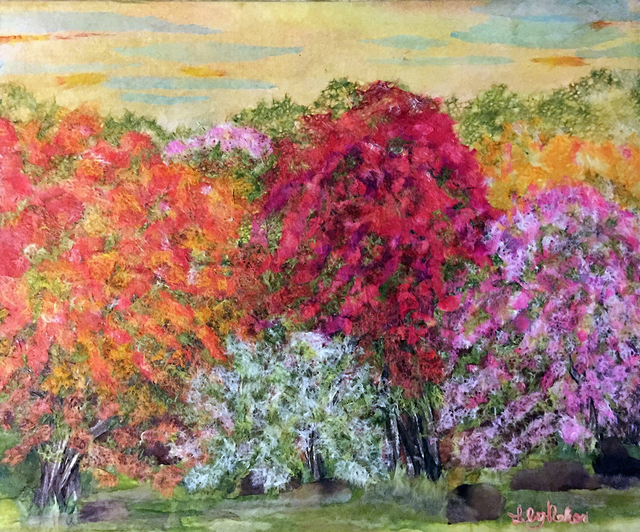Several washi chigiri-e students from Hilo will be traveling to Tokyo for the annual Hakubi Washi Chigiri-e Gakuin’s annual exhibition at Ueno No Mori Art Gallery from April 8-14.
More than 700 pieces of art by students from Japan will be on display.
Chigiri-e is a Japanese art form that uses handmade and hand-dyed Japanese paper called washi to create images, transforming them into beautiful pieces of art.
The students from Hilo are Roanne Tsutsui, John Tyler, Thais daRosa and Jan Higashi, who will travel with instructor Lily Nakao and her students from Oahu, Faye Murata, Nobuko Akamine, Emiko Shimoyama and Claudia Awai. Nakao will be exhibiting a large artwork called, “Colorful Bougainvillea of Hawaii.” Her students were invited to show one of their completed art as well, and for the first time, a Hawaii section will be a part of the exhibition.
Washi chigiri-e art classes, taught by Nakao, have been offered in Hilo by the Japanese Community Association of Hawaii and supported by Takayoshi Mizushima, chairman of Hakubi Kimono School, and the Hakubi Chigiri-e Gakuin in Tokyo.
Nakao was born in Hawaii but learned the art of chigiri-e while living in Japan for 40 years. She worked at the International School of the Sacred Heart in Japan and the Hakubi Kyoto Kimono School, studying washi chigiri-e art at the Hakubi Chigiri-e Gakuin, the foremost school in this art.
Since returning to Oahu, Nakao has been teaching at the Moiliili Community Center for the past 15 years and does workshops, demonstrations and exhibits her works at many locations throughout the state, including in Hilo at Japanese Culture Day in Hawaii and Kodomo No Matsuri. Their artworks were displayed in Mayor Billy Kenoi’s office in 2011.
“My mission is to share this art form with as many people as possible,” Nakao said. “I am very pleased that I have very dedicated and talented students who have helped to sustain the classes here in Hilo.”
The Japanese word “chigiri-e” is the combination of two basic words, “chigiri” is the noun form of the verb “chigiru” which means “to tear,” and “-e” is an artwork or picture painted through tearing of washi paper. The fineness of the art arises from using handmade Japanese washi paper. The results are elegant, soft pictures, some simple, some complex.
Classes are held six times a year in Hilo. The last class for this session is May 9. Fall classes resume in September.
The Japanese Community Association of Hawaii is a nonprofit organization formed in 1972 to promote and perpetuate the Japanese culture and arts in East Hawaii, and to foster international relationships with Japanese citizens and organizations.
For more information about the washi chigiri-e art classes or to join JCAH, call 969-6437, email jcahawaii@yahoo.com or go to its website at www.jcahawaii.org.






